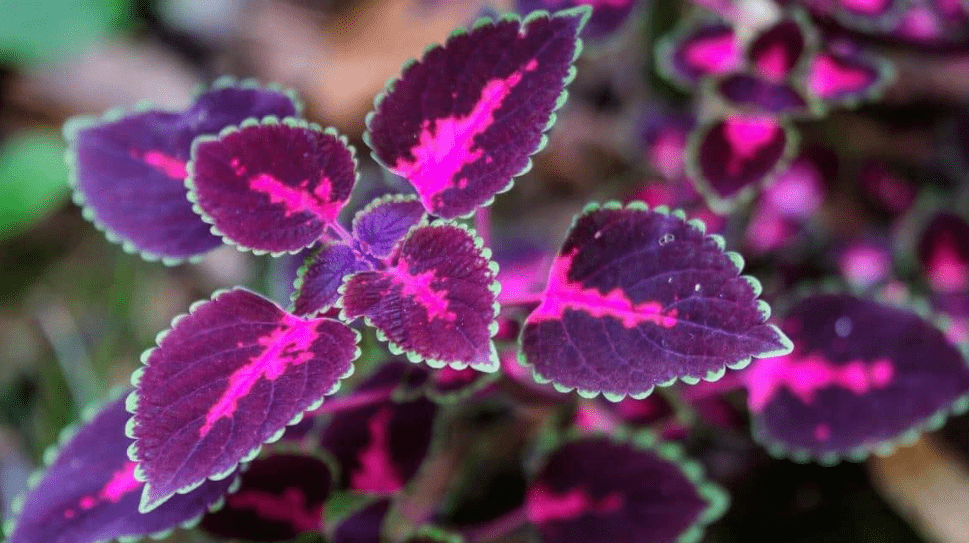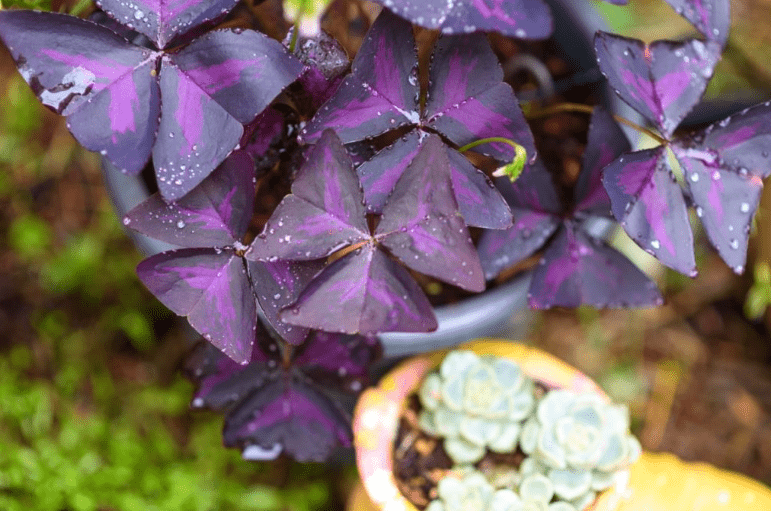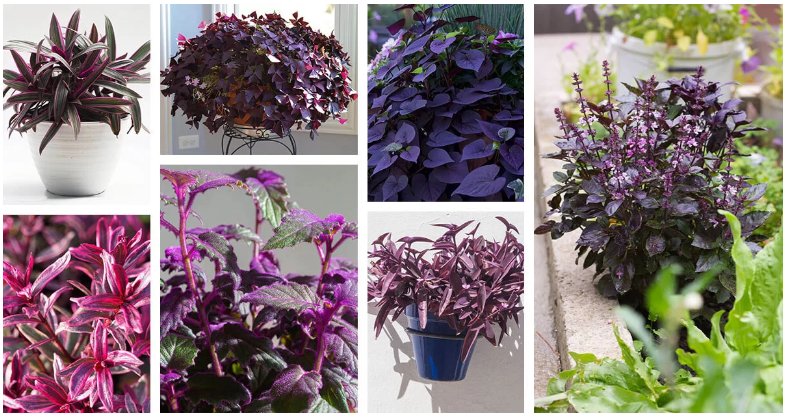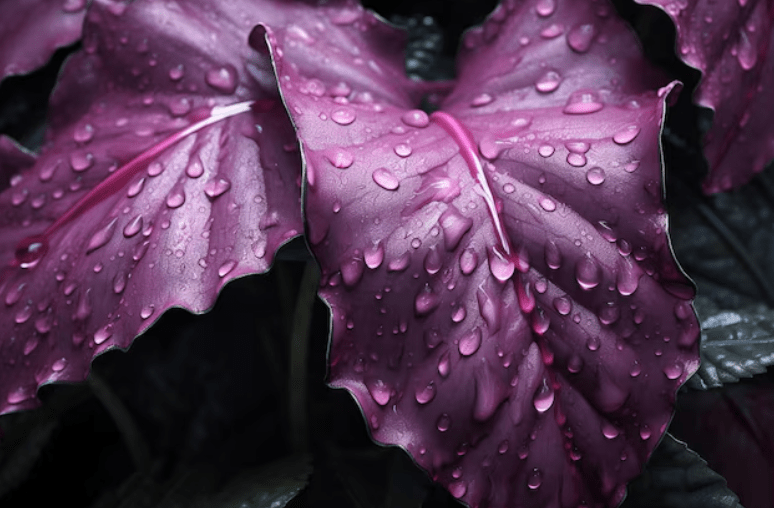
Choosing the Perfect Purple Leaf Plant for Your Outdoor Garden
Choosing the perfect purple leaf plant for your outdoor garden can transform your landscape into a vibrant and visually appealing haven. Purple foliage adds a unique depth and contrast that enhances garden aesthetics, making it a favorite choice among gardeners. This guide will help you navigate the selection process, ensuring you pick the ideal purple leaf plants that thrive in your specific conditions.
Table of Contents
ToggleThe Appeal of Purple Leaf Plants
1.Unique aesthetic qualities

Purple leaf plants add an element of uniqueness and interest to your garden. The contrast of the purple foliage against the greenery of other plants can create a visually stunning effect.
- Versatility: There are a variety of purple leaf plants to choose from, including shrubs, trees, and groundcovers, making them a versatile choice for different garden designs.
- Low maintenance: Many purple leaf plants are low maintenance and easy to care for, making them an attractive option for both novice and experienced gardeners.
2.Symbolism and cultural significance of purple plants
In various cultures, purple has been associated with royalty, spirituality, and luxury. Incorporating purple leaf plants into your garden can add a touch of symbolism and cultural significance, creating a meaningful and visually rich outdoor space.
Choosing the Right Purple Leaf Plant for Your Garden

- Consider your garden’s climate and conditions: It’s important to select purple leaf plants that are well-suited for your specific climate, soil type, and sunlight exposure. Some varieties may thrive in full sun, while others prefer shade.
- Size and growth habit: When choosing a purple leaf plant, consider the size and growth habit of the plant. Some may be compact and suitable for small spaces, while others may grow into large shrubs or trees.
- Maintenance requirements: Different purple leaf plants may have varying maintenance needs. Consider how much time and effort you’re willing to devote to caring for your garden and choose plants that align with your maintenance preferences.
- Design and aesthetic goals: Think about the overall design and aesthetic goals for your garden. Whether you’re aiming for a formal, structured look or a more natural, free-flowing style, there are purple leaf plants to suit your design vision.
Popular Purple Leaf Plant Options
- Purple Smoke Tree (Cotinus coggygria): Known for its smoky, purple foliage and airy, pinkish-purple flowers, the purple smoke tree is a striking addition to any garden.
- Purple Heart (Tradescantia pallida): This low-growing groundcover features deep purple leaves and delicate pink flowers, adding a pop of color to garden beds and borders.
- Purple-leaf Sand Cherry (Prunus x cistena): With its deep burgundy foliage and delicate pink blossoms, the purple-leaf sand cherry is a versatile and attractive choice for garden landscapes.
By carefully considering the appeal, suitability, and maintenance of various purple leaf plants, you can choose the perfect additions to your outdoor garden that will enhance its visual appeal and create a unique and vibrant oasis.
Factors to Consider When Choosing Purple Leaf Plants
1.Climate and Hardiness Zones
When choosing purple leaf plants for your outdoor garden, it’s important to consider the climate and hardiness zones of your area. Make sure to select plants that are suitable for the specific conditions of your garden, such as temperature, sunlight, and soil type. Some purple leaf plants may be more tolerant of heat or cold, so it’s essential to choose plants that will thrive in your specific climate. Additionally, consider the hardiness zones of the plants you’re interested in to ensure they can withstand the winter conditions in your area. By taking these factors into account, you can select purple leaf plants that will thrive and enhance the beauty of your outdoor garden.
A.Understanding USDA Hardiness Zones
USDA Hardiness Zones is crucial when choosing purple leaf plants for your outdoor garden. The USDA Hardiness Zone map divides North America into 13 different zones based on average minimum winter temperatures. This helps gardeners determine which plants are most likely to thrive in their specific region. By identifying your specific hardiness zone, you can select purple leaf plants that are well-suited to the climate and conditions in your area, ensuring their success and longevity in your garden. It’s important to research and understand the hardiness zones of the purple leaf plants you’re interested in to make sure they are suitable for your outdoor garden. By taking the time to consider climate and hardiness zones, you can choose the perfect purple leaf plants that will thrive and add beauty to your outdoor space.
2.Soil Type and Quality
Soil Type and Quality are also important considerations when selecting purple leaf plants for your outdoor garden. Different plants thrive in different soil types, so it’s important to assess the soil conditions in your garden before choosing your plants. Some purple leaf plants prefer well-draining soil, while others may require more moisture. Testing your soil and understanding its composition can help you select the right plants for your garden. Additionally, consider the hardiness zones of the plants you’re interested in to ensure they can withstand the winter conditions in your area. By taking these factors into account, you can select purple leaf plants that will thrive and enhance the beauty of your outdoor garden
A.Importance of soil pH and nutrient content
Soil pH and nutrient content play a crucial role in the health and growth of purple leaf plants. Different plants have different pH and nutrient requirements, so it’s important to test your soil and make any necessary adjustments before planting. The ideal pH range for most plants is between 6.0 and 7.0. If your soil’s pH is outside of this range, you can use amendments to adjust it. Additionally, ensuring that your soil has the right balance of essential nutrients, such as nitrogen, phosphorus, and potassium, is essential for the overall health and vibrancy of your purple leaf plants. Testing your soil and providing the correct nutrients can help your plants thrive and flourish in your outdoor garden.
3.Sunlight Requirements
Sunlight Requirements are another important factor to consider when choosing purple leaf plants for your outdoor garden. Some plants may require full sun, while others may thrive in partial shade. Before selecting a plant, make sure to assess the sunlight conditions in your garden and choose plants that are suited to those conditions. This will help ensure that your purple leaf plants receive the right amount of sunlight for optimal growth and health. Additionally, consider the placement of your plants to ensure they receive the appropriate amount of sunlight throughout the day. By taking sunlight requirements into account, you can select the right purple leaf plants for your outdoor garden and create a beautiful and thriving landscape.
A.Full sun vs. partial shade preferences
When choosing purple leaf plants for your outdoor garden, it’s important to consider their sunlight preferences. Some plants thrive in full sun, while others do better in partial shade. Before selecting a plant, assess the sunlight conditions in your garden and choose plants that are suited to those conditions. This will ensure that your purple leaf plants receive the right amount of sunlight for optimal growth and health. Additionally, consider the placement of your plants to ensure they receive the appropriate amount of sunlight throughout the day. By taking sunlight preferences into account, you can select the right purple leaf plants for your outdoor garden and create a beautiful and thriving landscape.
4.Watering Needs

In addition to sunlight requirements, it’s important to consider the watering needs of your purple leaf plants. Some plants prefer moist soil, while others thrive in drier conditions. Be sure to research the specific watering needs of the plants you choose and make sure to water them accordingly. Overwatering or underwatering can lead to stress and potential damage to your plants. By understanding the watering needs of your purple leaf plants, you can ensure they receive the proper care and attention to thrive in your outdoor garden.
A.Drought-tolerant options
Drought-tolerant options such as lavender or rosemary may be a good choice for areas with limited water access, while plants like coleus or Persian shield may require more frequent watering. Consider the climate and environment of your outdoor garden when selecting purple leaf plants and create a watering schedule that meets their needs. This will help your plants stay healthy and vibrant, creating a beautiful outdoor space for you to enjoy.
Types of Purple Leaf Plants
1.Annuals vs. Perennials
Annual purple leaf plants, such as purple fountain grass or purple sweet potato vine, typically have a shorter lifespan and will need to be replanted each year. Perennial purple leaf plants, like heuchera or purple coral bells, will come back year after year and may have different watering needs based on their specific variety. Be sure to research the specific watering needs of the annual or perennial purple leaf plants you choose for your outdoor garden to ensure they receive the proper care and attention.
2.Shrubs and Trees
Some purple leaf shrubs and trees, like purple smokebush or Japanese maple, may require deeper and less frequent watering to encourage their roots to grow deeper into the soil. Other shrubs and trees, such as purple leaf sand cherry or purple-leaf plum, may have more moderate watering needs. Understanding the specific watering requirements of the shrubs and trees in your outdoor garden will help you provide them with the appropriate care to thrive and flourish. Consider factors such as soil type, drainage, and climate when establishing a watering schedule for your purple leaf shrubs and trees. With proper care and attention, these plants can add beauty and vibrancy to your outdoor space.
3.Groundcovers and Vines
Groundcovers and vines with purple leaves, like purple wandering jew or purple heart plant, may have different watering needs based on their specific variety and growing conditions. Some groundcovers and vines may require regular watering to thrive, while others may be more drought-tolerant. It’s important to research the specific watering requirements of the groundcovers and vines you choose for your outdoor garden and adjust your watering schedule accordingly. Pay attention to factors such as soil moisture, sunlight exposure, and climate to ensure your purple leaf groundcovers and vines receive the proper care they need to grow and spread. With the right care, these plants can create a colorful and lush groundcover or add vertical interest to your outdoor space.
Designing with Purple Leaf Plants
1.Color Combinations and Garden Design Tips

When designing with purple leaf plants, it’s important to consider color combinations and garden design tips to create a cohesive and visually appealing outdoor space. Purple leaf plants can be used as focal points or accents in your garden design, and they pair well with a variety of other colors, such as silver, yellow, white, and pink. Consider using purple leaf plants as a backdrop for lighter-colored flowers or as a contrast to green foliage for a bold and striking effect. Additionally, you can use purple leaf plants to create depth and interest in your garden by varying the shades and textures of the plants you choose. By carefully planning and strategically placing purple leaf plants in your garden, you can create a beautiful and harmonious outdoor space that showcases their vibrant and unique color.
2.Layout and Placement
Consider the layout and placement of your purple leaf plants to create a balanced and visually appealing garden design. When deciding where to place your purple leaf plants, consider factors such as their size, shape, and growth habits. For example, taller purple leaf plants can be placed towards the back of a garden bed to provide a backdrop for shorter plants, while trailing vines can be used to create a cascading effect along a garden wall or trellis. Additionally, consider the sunlight and water requirements of your purple leaf plants when determining their placement in your garden. By carefully planning the layout and placement of your purple leaf plants, you can create a cohesive and well-designed outdoor space that showcases their beauty and adds visual interest to your garden.
3.Seasonal Interest
Purple leaf plants offer seasonal interest and can be a stunning addition to your garden throughout the year. During the spring and summer months, many purple leaf plants will produce vibrant foliage and may even bloom with colorful flowers. In the fall, the leaves of these plants may change to fiery shades of red, orange, or yellow, adding a pop of color to your garden as the seasons change. Some purple leaf plants may also offer winter interest, with unique textures or structures that stand out in a winter landscape. By choosing a variety of purple leaf plants with different seasonal characteristics, you can ensure that your garden maintains visual interest and beauty year-round.
Care and Maintenance of Purple Leaf Plants
1.General Care Tip
When caring for purple leaf plants, it’s important to consider their specific sunlight and water needs. Most purple leaf plants thrive in well-draining soil and prefer to be watered consistently, but not excessively. Additionally, it’s important to monitor for any pests or diseases that may affect the health of your purple leaf plants and address any issues promptly. Regular fertilization and pruning can also help maintain the health and appearance of your purple leaf plants. By providing proper care and maintenance, you can ensure that your purple leaf plants remain vibrant and beautiful in your garden.
A.Watering, feeding, and mulching practices
To ensure the health and vibrancy of your purple leaf plants, it’s important to water them consistently but not excessively. Overwatering can lead to root rot, so it’s best to allow the soil to dry out slightly between waterings. Additionally, regular fertilization with a balanced fertilizer can help meet the nutritional needs of your plants. Mulching around the base of your purple leaf plants can help retain moisture in the soil and suppress weed growth. However, be mindful not to mulch too close to the base of the plant to avoid causing rot or other issues. By following these watering, feeding, and mulching practices, you can help your purple leaf plants thrive in your garden.
2.Pruning and Trimming
Pruning and trimming your purple leaf plants is essential for maintaining their shape, size, and overall health. Regular pruning can help promote new growth and improve the overall appearance of the plant. It’s important to remove any dead or damaged branches and stems to prevent disease and promote air circulation. Additionally, trimming back overgrown or leggy growth can help maintain a more compact and tidy appearance for your purple leaf plants. It’s best to prune your plants in the early spring before new growth begins, but you can also do light pruning throughout the growing season as needed. With proper pruning and trimming, you can help keep your purple leaf plants looking their best.
3.Pest and Disease Management
Pest and disease management is crucial for the health and longevity of your purple leaf plants. Regularly inspect your plants for any signs of pests or diseases, such as discolored leaves, holes, or unusual growth patterns. If you notice any issues, it’s important to take appropriate action to prevent further damage.
There are various methods for managing pests and diseases, including using organic pesticides, introducing beneficial insects, and practicing good garden hygiene. Removing any affected leaves or branches can help prevent the spread of disease, and regularly cleaning up fallen leaves and debris can reduce the risk of pests taking hold in your garden.
By staying vigilant and addressing any issues promptly, you can help protect your purple leaf plants from pests and diseases and ensure they continue to thrive in your garden.
Sustainable Gardening Practices
1.Organic Gardening Methods
Organic gardening methods are an important aspect of caring for purple leaf plants. By using organic practices, you can help maintain a healthy and sustainable environment for your garden. This includes using natural fertilizers and soil amendments, avoiding synthetic pesticides and herbicides, and utilizing compost and mulch to improve soil health. Additionally, practicing crop rotation and intercropping can help prevent disease and pest problems. By incorporating organic gardening methods into your routine, you can support the overall health and resilience of your purple leaf plants while minimizing the impact on the environment.
2.Water Conservation Techniques
Water conservation is crucial for sustainable gardening, especially for purple leaf plants. By implementing water conservation techniques such as drip irrigation, rainwater harvesting, and using mulch to retain soil moisture, you can reduce water usage and support the health of your plants. It’s important to water your plants at the right time and in the right amount to avoid water waste and promote strong root growth. Additionally, choosing drought-tolerant plant varieties and implementing efficient watering practices can help conserve water while maintaining a lush and thriving garden. By incorporating water conservation techniques into your gardening routine, you can support the health of your purple leaf plants and contribute to a sustainable and eco-friendly garden.
3.Supporting Local Wildlife
Supporting local wildlife is important for creating a balanced and thriving ecosystem in your garden. By providing food, water, and shelter for birds, insects, and other wildlife, you can encourage natural pest control and pollination, ultimately supporting the overall health of your purple leaf plants. Planting native flowers and plants, avoiding the use of chemical pesticides and herbicides, and creating wildlife-friendly habitats such as birdhouses and butterfly gardens can all contribute to supporting local wildlife. Additionally, incorporating water features such as birdbaths or small ponds can provide essential hydration for wildlife. By supporting local wildlife in your garden, you can create a sustainable and harmonious environment for your purple leaf plants and other living organisms.
In conclusion, when choosing the perfect purple leaf plant for your outdoor garden, it’s important to consider the climate, soil conditions, and amount of sunlight in your garden. Some popular options include Purple Heart, Purple Fountain Grass, and Persian Shield. Each of these plants has its own unique characteristics and requirements, so be sure to do your research and choose the one that best fits your garden needs. With the right choice, you can add a beautiful pop of color and texture to your outdoor space.
Frequently Asked Question
Some popular purple leaf plants for outdoor gardens include purple fountain grass, purple basil, purple heart plant, and purple smoke tree.
Consider the climate and soil conditions in your area, as well as the amount of sunlight your garden receives. Some purple leaf plants may require more sunlight or well-drained soil, so it’s important to choose a plant that will thrive in your specific garden environment.
Many purple leaf plants are low-maintenance and require minimal care. However, it’s important to research the specific care requirements for the plant you choose, such as watering frequency and pruning needs.
Absolutely! Purple leaf plants can add a beautiful pop of color and contrast to your garden when mixed with other green or flowering plants. Just be sure to consider the growth habits and care needs of all the plants in your garden when planning your design.
Some purple leaf plants, such as purple basil, can attract pollinators like bees and butterflies with their flowers. Consider incorporating these plants into your garden to support local pollinator populations.
Yes, many purple leaf plants can be grown in containers, making them a versatile option for gardens with limited space or for adding visual interest to patios and balconies.
Some purple leaf plants may be more susceptible to certain pests or diseases, so it’s important to monitor the health of your plants and address any issues promptly. Additionally, some purple leaf plants may require regular pruning to maintain their shape and appearance.
You can find a variety of purple leaf plants at local nurseries, garden centers, and online plant retailers. Be sure to choose healthy, well-established plants with vibrant foliage for the best results in your garden.
